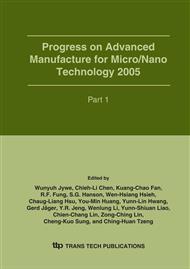[1]
J. I. Pascual, J. Méndez, J. Gómez-Herrero, A. M. Baró, and N. García: Phys. Rev. Lett., Vol. 71(12) (1993), pp.1852-1855.
DOI: 10.1103/physrevlett.71.1852
Google Scholar
[2]
G. Rubio, N. Agraït, and S. Vieira: Phys. Rev. Lett., Vol. 76(13) (1996), pp.2302-2305.
Google Scholar
[3]
D. Erts, A. Lõhmus, R. Lõhmus, H. Olin, A. V. Pokropivny, L. Ryen, and K. Svensson: Appl. Surf. Sci., Vol. 188 (2002), pp.460-466.
DOI: 10.1016/s0169-4332(01)00933-3
Google Scholar
[4]
D. Fujita, Q. Jiang, and H. Nejoh: J. Vac. Sci. Technol. B, Vol. 14(6) (1996), pp.3413-3419.
Google Scholar
[5]
Stefan Berbner and Friedrich Löffler: Powd. Technol., Vol. 78 (1994), pp.273-280.
Google Scholar
[6]
L. Kuipers, M.S. Hoogeman, J.W.M. Frenken: Surf. Sci., Vol. 340 (1995), pp.231-24.
Google Scholar
[7]
Gary Toikka, Geoffrey M. Spinks, and Hugh R. Brown: Langmuir, Vol. 17 (2001), pp.6207-6212.
Google Scholar
[8]
Advanced Storage Technologies Group and Micro-/Nanomechanics Group of IBM: A Nanotechnology-based Approach to Data Storage (Proceedings of the 29th VLDB Conference, Germany 2003).
Google Scholar
[9]
B. Bhushan: Handbook of Micro/Nano Tribology (CRC Press, Boca Raton 1995).
Google Scholar
[10]
T. H. Fang, C. I. Weng, and J. G. Chang: Surf. Sci., Vol. 501 (2002), pp.138-147.
Google Scholar
[11]
G. V. Dedkov: Phys. Stat. Sol. (a), Vol. 179 (2000), pp.3-75.
Google Scholar
[12]
U. Landman, W. D. Luedtke, N. A. Burnham, and R. J. Colton: Science, Vol. 248 (1990), pp.454-461.
Google Scholar
[13]
R. Komanduri, N. Chandrasekaran, and L. M. Raff: Phys. Rev. B, Vol. 61(2000), pp.14007-14019.
DOI: 10.1103/physrevb.61.14007
Google Scholar
[14]
K. Maekawa and A. Itoh: Wear, Vol. 188 (1995), pp.115-122.
Google Scholar
[15]
A. M. Childs, M. H. Shapiro, and T. A. Tombrello: Nucl. Instr. and Meth. in Phys. Res. B, Vol. 143 (1998), pp.298-305.
Google Scholar
[16]
J. M. Haile: Molecular Dynamics Simulation (John Wiley & Sons, New York 1992).
Google Scholar
[17]
K. Takayanagi, Y. Kondo, and H. Ohnishi: JEOL News, Vol. 34E(1) (1999), pp.20-23.
Google Scholar
[18]
J. Israelachvili: Intermolecular & Surface Forces (Academic Press, San Diego 1992).
Google Scholar


